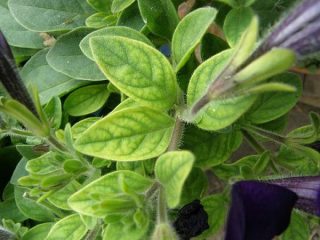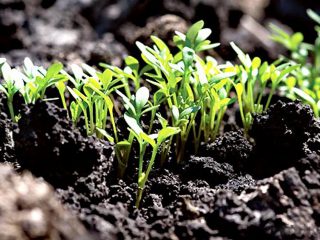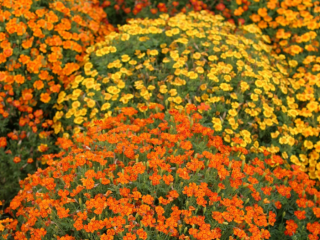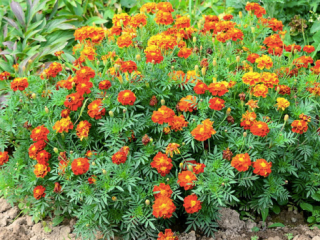Rocky alyssum is a ground cover plant that attracts with its abundant flowering and honey aroma. Below we discuss planting and caring for rock alyssum, photos and main varieties.
General characteristics
Rocky alyssum is a perennial, reaching 30 cm in height. It grows in the form of hemispherical bushes 40 cm in size. The stems are highly branched and become woody at the base.
The leaves are elongated, pubescent, gray in color. The flowers are small, bright yellow, bloom in inflorescences. The flowers have a strong honey aroma that attracts bees and other pollinators.
The flower consists of 4 sepals and petals, arranged in a checkerboard pattern. Pollination occurs with the help of insects. In autumn, the plant produces fruits in the form of pods filled with seeds.
In nature, rock alyssum is found in Europe and southern Siberia. Flowering begins in spring and lasts for 40 days. At the end of summer, re-formation of inflorescences is possible.
The flower has been known since the 18th century. Its composition has not been fully studied, but the seeds contain organic acids and oils. The leaves and inflorescences of the plant have a diuretic and laxative effect.
The plant is used for decorating single and multi-flowered flower beds and borders. Ideal for decorating alpine slides. The flower tolerates cold temperatures down to -15°C, but is demanding of good lighting.
Main varieties
For planting on a summer cottage, various varieties of rock alyssum are used. All varieties are resistant to adverse weather conditions and bloom profusely.
golden wave
Alyssum of the Golden Wave variety is a highly branched perennial plant, reaching a height of 25 cm. The size of the bushes is 30-40 cm. The flowers are small, rich yellow.
The plant is propagated by seeds, cuttings and by dividing the bush. When grown from seeds of rock alyssum Golden Wave, abundant flowering begins in May.
After planting, flowering begins in the second year. A distance of 30 cm is maintained between plants. The variety is unpretentious and grows on soils of any composition.
Gold placer
Alyssum rocky Golden placer is a brightly flowering perennial, after planting it quickly grows and covers the plantings with a carpet. The plant forms many shoots.
Against the background of gray-green foliage, yellow small flowers appear, collected in inflorescences. Plant height 20 cm, flowering from early May to June. Alyssum rocky Gold placer prefers lightly drained soils and is resistant to frost and drought.
Inca gold
Alyssum Inca Gold – ground cover perennial. Forms a dense bush up to 15 cm high. The shoots grow quickly and cover the ground. The shoots are branched, the leaves are gray-green.
Small yellow flowers are collected in inflorescences up to 5 cm in size. The flower has a pronounced honey aroma.
Alyssum yellow
Yellow alyssum is a low-growing perennial subshrub, reaching a height of 10-20 cm.The shoots of the plant are ascending and recumbent, the leaves are pubescent.
The inflorescences are bright yellow with a honey aroma. Prefers bright and dry places. Definitely requires summer pruning.
Photo of rock alyssum during planting and care:
Alyssum golden
Strongly branched perennial, forming bushes up to 25 cm high. Grows on light soils, neutral or slightly alkaline. The plant tolerates dampness and responds positively to the application of organic fertilizers.
Flowering begins at the end of May and lasts 1.5 months. The flowers are small, bright yellow, collected in inflorescences. Secondary flowering is possible at the end of August and until the end of September.
Landing
When propagated by seeds, alyssum seedlings are first obtained, which are planted in the ground. It is allowed to plant seeds immediately in a permanent place. It is important to choose a lighted area for the flower and prepare the soil.
Selecting a location
Alyssum is an unpretentious plant, but its development and abundant flowering occur with the right choice of planting site.
Primary requirements:
- constant sun exposure, in the southern regions - partial shade;
- fertile light soil;
- presence of drainage.
The flower grows well on slabs and stones heated by the sun. Heavy clay soil is fertilized with coarse river sand. Be sure to add humus.
Growing from seeds
In cold regions, alyssum is grown from seeds in seedlings. To do this, prepare light soil with a low lime content at home. The seeds of the plant are purchased in the store or collected in the fall after flowering has ended.
The soil is steamed in a water bath for disinfection and poured into boxes. The flower seeds are laid out on the surface and covered with a thin layer of earth. The plantings are watered and covered with glass or film.
Young plants are provided with certain conditions:
- temperature from 10 to 15°C;
- regular ventilation of the room;
- adding moisture.
Germination of alyssum seeds occurs in 1-2 weeks. When the first leaf appears on the seedlings, they are fed with complex flower fertilizer.
When 2-3 leaves appear, the seedlings are planted in separate containers. If weather conditions permit, you can do without picking and immediately move the plant into the ground.
When planting, take into account that the flower grows quickly. Leave 40 cm between plants. Alyssum seedlings are placed in planting holes without a recess. The roots are covered with soil and watered abundantly.
When grown without seedlings, the seeds are planted in early May. The planting material is deepened by 1.5 cm and watered. When the shoots appear, they need to be thinned out. When planted in spring, flowering will begin later.
Growing Golden Wave rock alyssum and other varieties from seeds is possible by planting before winter. In November, the seeds are planted in the ground; during the winter they will undergo natural stratification. After the snow melts, strong shoots will appear, and the plant will bloom in May.
Vegetative propagation
Rock alyssum is propagated vegetatively. In summer, shoots are cut and rooted in fertile soil. The cuttings are planted in a greenhouse or conservatory and protected from drafts and cold snaps. When the plant takes root, it is planted in a permanent place. Leave 30 cm between seedlings.
Alyssum is rarely propagated by dividing the bush. In order for the plant to take root, you need to divide the bush before April. To do this, dig up an old bush and cut it into pieces. The resulting planting material is planted in a permanent place and watered abundantly.
Care
Alyssum is cared for by watering, loosening the soil and eliminating weed. Feeding helps stimulate the formation of new shoots. The plant is pruned to maintain its decorative appearance.
Watering
Rock alyssum needs regular watering. In drought and lack of moisture, the plant sheds buds and inflorescences. Abundant watering is effective if the soil has good water permeability. Stagnation of moisture provokes rotting of the roots and death of the plant.
The plant is watered with warm water, settled in barrels. It is better to apply moisture in the morning or evening so that it has time to be absorbed before direct sunlight appears. For irrigation, the sprinkling method is used. Under the pressure of water, the roots of the plant are exposed.
After watering, the soil is loosened to improve its water permeability. Be sure to weed out weeds that interfere with the development of the flower. To maintain soil moisture after planting alyssum, mulch with peat or straw.
Top dressing
When grown on fertile soils, alyssum is fed once at the beginning of the season. Use any flower or nitrogen fertilizer. Due to nitrogen, there is an active increase in the green mass of the plant.
For 10 liters of water add 1 tbsp. l. urea. The resulting solution is watered over the plantings. Before flowering alyssum, complex fertilizer is applied.
Up to 4 feedings are allowed per season. A gap of 2 weeks is made between plant treatments.
Trimming
Timely pruning of alyssum ensures its continuous flowering.In spring, last year's flowers, frozen and weak shoots are removed.
In the summer after flowering, the flower is pruned again. All shoots are shortened by 5 cm. This treatment stimulates the re-formation of inflorescences. After pruning, the plant takes on a well-groomed appearance.
Diseases and pests
The most dangerous pest for flowers is the cruciferous flea beetle. To remove it, prepare a solution consisting of 1 tbsp. l. vinegar and 10 liters of water. Only mature bushes are treated.
Caterpillars pose a danger to the flower. An infusion based on chamomile and tobacco is used against these pests. To make the solution stick to the leaves better, add a little crushed soap to it.
The disease also affects the root system. To combat the disease, fungicides Ordan, Kuproxat or copper oxychloride are used.
Alyssum is susceptible to powdery mildew, which appears as a white or grayish coating resembling powder. The disease spreads the mycelium of the fungus, penetrating the plant cells.
The infection covers the lower leaves of the plant and gradually moves to the upper part of the flower. To get rid of powdery mildew, prepare a solution of Bordeaux mixture or Topaz.
Preparing for winter
Rock alyssum does not tolerate severe cold in winter. To protect against frost in the fall, the plant is covered with dry leaves. Additionally, a pile of snow is placed on the flower in winter. Under such shelter, alyssum will withstand cold weather and keep the leaves green.
It is not recommended to prune the flower in winter.It is enough to carry out preventive removal of shoots after flowering.
Conclusion
Rocky alyssum is a winning option for decorating a summer cottage. The flower is unpretentious and easily propagated by seeds and cuttings. The plant is provided with minimal care, including watering and periodic feeding. Subject to proper growing conditions, alyssum blooms for a long time and is not susceptible to disease.
















